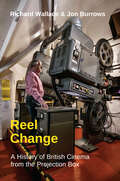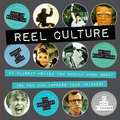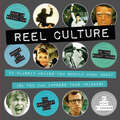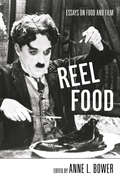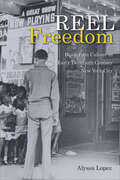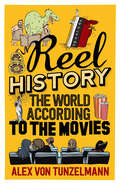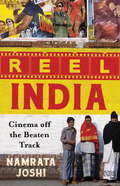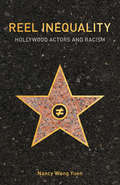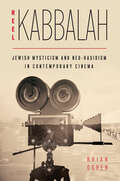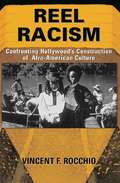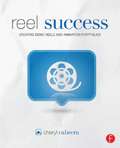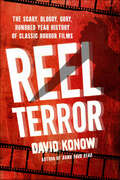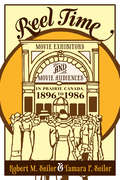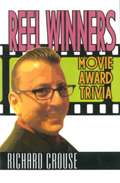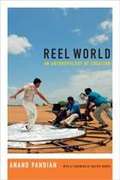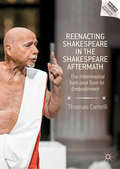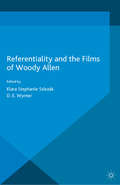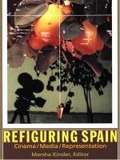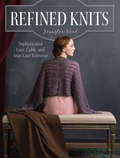- Table View
- List View
Reel Change: A History of British Cinema from the Projection Box
by Richard Wallace Jon BurrowsTen years ago, a technological revolution swept through cinemas around the world, as analogue projectors were replaced with digital equipment. It was not just the plastic medium of film that was removed from projection boxes during this transformation; most cinemas took this opportunity to also evict the human projectionists who were hitherto in charge of screenings. Projectionists had been hidden from the sight of audiences for most of the history of photographic moving image projection, and their redundancies went largely unnoticed and unremarked upon. This book focuses attention on what has been happening behind film spectators' heads for the past 130 years, and attempts to write the history of cinema in Britain from the perspective of its habitually overlooked and undervalued projectionists, beginning in the silent era and continuing to the present day. Drawing upon extensive archival research and lengthy interviews with former projectionists, it documents the key facets and challenges of their work, and how these evolved in response to previous waves of significant technological change. It evaluates how projectionists helped to design and maintain key aesthetic characteristics of the 20th century big screen experience. It shows how the institution of cinema in Britain has been historically underpinned by the harsh exploitation of projectionists by many employers, detailing inadequate wage levels and poor working conditions that formerly provoked government investigation, and explaining why these problems were never successfully ameliorated by trade unions. It also charts in depth the recent fateful transition to digital projection, delineating how and why projectionists were so swiftly and ruthlessly consigned to the past, and assessing whether this form of entertainment should be considered diminished by their super session.
Reel Culture
by Mimi O'ConnorTeens love movies. But when we start talking about the movies from last century, they're often in the dark. Reel Culture is for the young person who is curious about film history, and wants to be the one at the party who knows what Casablanca was about or who first made the LBD (little black dress) hot in Breakfast at Tiffany's. From Willy Wonka and the Chocolate Factory to Raiders of the Lost Ark, Reel Culture explores the 50 most influential--yet often unknown to teens--films of the 20th century.
Reel Culture: 50 Movies You Should Know About (So You Can Impress Your Friends)
by Mimi O'ConnorReel Culture is for the young person who is curious about film history and wants to be the one at the party who knows what Casablanca was about or who made the LBD (little black dress) hot in Breakfast at Tiffany's. From Willy Wonka and the Chocolate Factory to Raiders of the Lost Ark, Reel Culture explores the 50 most influential—yet often unknown to teens—films of the 20th century.
Reel Food: Essays on Food and Film
by Anne L. BowerFirst published in 2005. Routledge is an imprint of Taylor & Francis, an informa company.
Reel Freedom: Black Film Culture in Early Twentieth-Century New York City (Urban Life, Landscape and Policy)
by Alyssa LopezReel Freedom intimately captures the relationship between Black film culture and space in New York City. Alyssa Lopez argues that Black film culture, from its origins in the early twentieth century to its firm establishment in the 1930s, was necessarily both entertainment and resistance, connected as it was to Black New Yorkers’ demands for access and equality in the city. Lopez investigates how ordinary people, labor activists, journalists, filmmakers, theater managers, and owners all shaped Black film culture. Black girls and women used moviegoing as a means of independence and control over their lives. Race filmmaker Oscar Micheaux fought with New York State’s censorship board to get his films screened with limited edits in local theaters. And Harlem’s Black projectionists battled for unionization and fair pay, while journalists linked cinema to Black New Yorkers’ lived experiences. In Reel Freedom, Lopez chronicles the wide-ranging and remarkable pervasiveness of Black film culture in New York City, redefining a period and place most associated with the Harlem Renaissance. In doing so, she illustrates how Black New Yorkers leveraged cinema to make the city their own and to enjoy urban living to its fullest. In the series Urban Life, Landscape, and Policy
Reel History: The World According to the Movies
by Alex Von TunzelmannFrom ancient Egypt to the Tudors to the Nazis, the film industry has often defined how we think of the past. But how much of what you see on the screen is true? Picking her way through Hollywood's version of events, an acclaimed historian sorts fact from fiction. Based on the long-running column in the Guardian, Reel History takes a comic look at the history of the world as told through the movies—the good, the bad, and the very, very ugly.
Reel India: Cinema off the Beaten Track
by Namrata Joshi‘Picture abhi baaki hai…’ If there’s one experience that unites India, it is cinema. In Reel India, award-winning film critic Namrata Joshi journeys through the interiors of the country intimately chronicling little-known accounts about the nation’s incessant obsession with the movies. In Lucknow, she encounters a Shah Rukh Khan fan who has embraced an alternate reality in which he lives and breathes the star. In Wai, she finds an entire economy fuelled by the film industry as the town transforms into a film set. An activist filmmaker in Odisha demonstrates how he teaches local tribal people the basics of his craft, empowering them to train the spotlight on issues threatening their habitat and livelihood. From the fever pitch of the ‘first day first show’ in makeshift halls to the rivalries of regional cinema, this is India’s immersion in the movies like it’s never been seen before. Filled with real-life stories that are as fascinating as the revelations and insights they offer, Reel India raises the curtain on the starry-eyed dreams and big-screen passions that live on after the final ‘cut’ is announced.
Reel Inequality: Hollywood Actors and Racism
by Nancy Wang YuenWhen the 2016 Oscar acting nominations all went to whites for the second consecutive year, #OscarsSoWhite became a trending topic. Yet these enduring racial biases afflict not only the Academy Awards, but also Hollywood as a whole. Why do actors of color, despite exhibiting talent and bankability, continue to lag behind white actors in presence and prominence? Reel Inequality examines the structural barriers minority actors face in Hollywood, while shedding light on how they survive in a racist industry. The book charts how white male gatekeepers dominate Hollywood, breeding a culture of ethnocentric storytelling and casting. Nancy Wang Yuen interviewed nearly a hundred working actors and drew on published interviews with celebrities, such as Viola Davis, Chris Rock, Gina Rodriguez, Oscar Isaac, Lucy Liu, and Ken Jeong, to explore how racial stereotypes categorize and constrain actors. Their stories reveal the day-to-day racism actors of color experience in talent agents’ offices, at auditions, and on sets. Yuen also exposes sexist hiring and programming practices, highlighting the structural inequalities that actors of color, particularly women, continue to face in Hollywood. This book not only conveys the harsh realities of racial inequality in Hollywood, but also provides vital insights from actors who have succeeded on their own terms, whether by sidestepping the system or subverting it from within. Considering how their struggles impact real-world attitudes about race and diversity, Reel Inequality follows actors of color as they suffer, strive, and thrive in Hollywood.
Reel Kabbalah: Jewish Mysticism and Neo-Hasidism in Contemporary Cinema
by Brian OgrenReel Kabbalah: Jewish Mysticism and Neo-Hasidism in Contemporary Cinema studies the ways in which fictional film in the first decade of the twenty-first century represents the esoteric Jewish speculative traditions known as Kabbalah and Hasidism. It examines the textual and conceptual traditions behind five important cinematic representations -- Pi (1998), Ushpizin (2004), Bee Season (2005), The Secrets (2007), and A Serious Man (2009) -- and it considers how film both stands in continuity with those traditions and modifies them in the New Age vein of what is known as neo-Kabbalah and neo-Hasidism. Brian Ogren transforms our understanding of reception history by focusing on how cinema has altered perceptions of Jewish mysticism. In showing how the Jewish speculative traditions of Kabbalah and Hasidism have been able to affect mass-consumed cinematic portrayals of ultimate Truth, this book sheds light on the New Age, pop-cultural dialectic of the particular within the universal and of the universal within the particular.
Reel Racism
by Vincent F. RocchioReel Racism: Confronting Hollywood's Construction of Afro-American Culture goes beyond reflection theories of the media to examine cinema's active participation in the operations of racism --a complex process rooted in the dynamics of representation. Written for undergraduates and graduate students of film studies and philosophy, Reel Racism focuses on methods and frameworks that analyze films for their production of meaning and how those meanings participate in a broader process of justifying, naturalizing, or legitimizing difference, privilege, and violence based on race. In addition to analyzing how the process of racism is articulated in specific films, Reel Racism examines how specific meanings can resist their function of ideological containment, and instead, offer a perspective of a more collective, egalitarian social system-- one that transcends the discourse of race.
Reel Racism
by Vincent F. RocchioReel Racism: Confronting Hollywood's Construction of Afro-American Culture goes beyond reflection theories of the media to examine cinema's active participation in the operations of racism --a complex process rooted in the dynamics of representation. Written for undergraduates and graduate students of film studies and philosophy, Reel Racism focuses on methods and frameworks that analyze films for their production of meaning and how those meanings participate in a broader process of justifying, naturalizing, or legitimizing difference, privilege, and violence based on race. In addition to analyzing how the process of racism is articulated in specific films, Reel Racism examines how specific meanings can resist their function of ideological containment, and instead, offer a perspective of a more collective, egalitarian social system-- one that transcends the discourse of race.
Reel Racism
by Vincent F. RocchioReel Racism: Confronting Hollywood's Construction of Afro-American Culture goes beyond reflection theories of the media to examine cinema's active participation in the operations of racism --a complex process rooted in the dynamics of representation. Written for undergraduates and graduate students of film studies and philosophy, Reel Racism focuses on methods and frameworks that analyze films for their production of meaning and how those meanings participate in a broader process of justifying, naturalizing, or legitimizing difference, privilege, and violence based on race. In addition to analyzing how the process of racism is articulated in specific films, Reel Racism examines how specific meanings can resist their function of ideological containment, and instead, offer a perspective of a more collective, egalitarian social system-- one that transcends the discourse of race.
Reel Racism
by Vincent F. RocchioFor undergraduates and graduate students of film and media studies and philosophy, an analysis of mainstream cinema's participation in societal racism. Rocchio (film studies, Dartmouth) analyzes how films produce meaning and how those meanings in turn lead to a broad process of justifying, naturalizing, or legitimizing difference, privilege, and violence based on race. The text grew out of a series of lectures Rocchio developed for a course on racism and representation at St. John's U. , Queens. Annotation c. Book News, Inc. , Portland, OR (booknews. com)
Reel Success: Creating Demo Reels and Animation Portfolios
by Cheryl CabreraAre you an animator looking to get your foot in the door to the top studios? It's tough if you don't have a demo reel and portfolio that reflects your unique style and incredible talents. The reception of that reel will make or break you; so it's no wonder that creating a demo reel can be such a daunting task. Reel Success by Cheryl Cabrera can help. This book guides you into putting the right content into your portfolio, how to cater to the right audience, and how to harness the power of social media and network effectively. Accompanied by case studies of actual students' demo reels, this book teaches how to develop a critical eye toward effective and ineffective demo reels. Looking to get your foot in the door? Break it down with Reel Success.
Reel Terror: The Scary, Bloody, Gory, Hundred Year History of Classic Horror Films
by David KonowFrom the author of the definitive heavy metal history, Bang Your Head, a behind-the-scenes look a century of horror filmsReel Terror is a love letter to the wildly popular yet still misunderstood genre that churns out blockbusters and cult classics year after year. From The Cabinet of Dr. Caligari to Paranormal Activity, Konow explores its all-time highs and lows, why the genre has been overlooked, and how horror films just might help us overcome fear. His on-set stories and insights delve into each movie and its effect on American culture.For novices to all out film buffs, this is the perfection companion to this Halloween's movie marathons.
Reel Time: Movie Exhibitors and Movie Audiences in Prairie Canada, 1896 to 1986
by Robert M. Seiler Tamara P. SeilerIn this authoritative work, Seiler and Seiler argues that the establishment and development of moviegoing and movie exhibition in Prairie Canada is best understood in the context of changing late-nineteenth-century and early-twentieth-century social, economic, and technological developments. From the first entrepreneurs who attempted to lure customers in to movie exhibition halls, to the digital revolution and its impact on moviegoing, Reel Time highlights the pivotal role of amusement venues in shaping the leisure activities of working- and middle-class people across North America. As marketing efforts, the lavish interiors of the movie palace and the romantic view of the local movie theatre concealed a competitive environment in which producers, exhibitors, and distributors tried to monopolize the industry and drive their rivals out of business. The pitched battles and power struggles between national movie theatre chains took place at the same time that movie exhibitors launched campaigns to reassure moviegoers that theatres were no longer the “unclean and immoral places of amusement” of yesteryear. Under the leadership of impresarios, the movie theatre rose up from these attacks to become an important social and cultural centre – one deemed “suitable for women and children.” An innovative examination of moviegoing as a social practice and movie exhibition as a commercial enterprise, Reel Time depicts how the industry shaped the development of the Canadian Prairie West and propelled the region into the modern era.
Reel Winners: Movie Award Trivia
by Richard CrouseDo you know which televised awards show gives a prize for "Favourite Smile"?Or which Oscar host announced that he was going to raffle off a car during the ceremony?Do you know who won the Golden Raspberry Award for Worst Actress of the 20th Century? In Reel Winners, Richard Crouse, Reel to Real movie critic and CBC Radio’s "titan of trivia," gives you the lowdown on movie awards, from eight decades of Hollywood self-congratulation to international awards to the toasts from the fringe (like The Skinnies, which celebrate actors and their skin conditions). Reel Winners is the definitive guide to the inside scoop on movie awards.
Reel Wisdom: The Complete Quote Collection for Movie Lovers, Film Buffs and Cinephiles
by Roger Friedman Sean K. Smith"All of life's riddles are answered in the movies." -Steve Martin Reel Wisdom collects over 125 timeless quotes from the movies and film characters who have long captured the hearts and minds of all who see them. Assembled and organized into easy-to-use sections, based around themes like love, determination, common sense and more, these quotes offer the sort of guidance, strength and inspiration only found on the silver screen.
Reel World: An Anthropology of Creation
by Anand Pandian Walter MurchReel World explores what happens to life when everything begins to look and feel like cinema. Drawing on years of fieldwork with Tamil filmmakers, artists, musicians, and craftsmen in the south Indian movie studios of "Kollywood," Anand Pandian examines how ordinary moments become elements of a cinematic world. With inventive, experimental, and sometimes comical zeal, Pandian pursues the sensory richness of cinematic experience and the adventure of a writing true to these sensations. Thinking with the visceral power of sound and image, his stories also broach deeply philosophical themes such as desire, time, wonder, and imagination. In a spirit devoted to the turbulence and uncertainty of genesis, Reel World brings into focus an ecology of creative process: the many forces, feelings, beings, and things that infuse human endeavors with transformative potential.
Reel to Real: Race, class and sex at the movies (Routledge Classics)
by bell hooksMovies matter – that is the message of Reel to Real, bell hooks’ classic collection of essays on film. They matter on a personal level, providing us with unforgettable moments, even life-changing experiences and they can confront us, too, with the most profound social issues of race, sex and class. Here bell hooks – one of America’s most celebrated and thrilling cultural critics – talks back to films that have moved and provoked her, from Quentin Tarantino’s Pulp Fiction to the work of Spike Lee. Including also her conversations with master filmmakers such as Charles Burnett and Julie Dash, Reel to Real is a must read for anyone who believes that movies are worth arguing about.
Reenacting Shakespeare in the Shakespeare Aftermath: The Intermedial Turn and Turn to Embodiment (Reproducing Shakespeare)
by Thomas CartelliIn the Shakespeare aftermath—where all things Shakespearean are available for reassembly and reenactment—experimental transactions with Shakespeare become consequential events in their own right, informed by technologies of performance and display that defy conventional staging and filmic practices. Reenactment signifies here both an undoing and a redoing, above all a doing differently of what otherwise continues to be enacted as the same. Rooted in the modernist avant-garde, this revisionary approach to models of the past is advanced by theater artists and filmmakers whose number includes Romeo Castellucci, Annie Dorsen, Peter Greenaway, Thomas Ostermeier, Ivo van Hove, and New York’s Wooster Group, among others. Although the intermedial turn taken by such artists heralds a virtual future, this book demonstrates that embodiment—in more diverse forms than ever before—continues to exert expressive force in Shakespearean reproduction’s turning world.
Referentiality and the Films of Woody Allen
by D. E. WynterReferentiality and the Films of Woody Allen is a scholarly collection that provides expansive exploration of the auteur's use of intertexuality, referentiality, and fusion of media forms. Its scope is framed by Allen's intermedial phase beginning in 1983 with Zelig and his most recent film.
Refiguring Spain: Cinema/Media/Representation
by Marsha KinderIn Refiguring Spain, Marsha Kinder has gathered a collection of new essays that explore the central role played by film, television, newspapers, and art museums in redefining Spain's national/cultural identity and its position in the world economy during the post-Franco era. By emphasizing issues of historical recuperation, gender and sexuality, and the marketing of Spain's peaceful political transformation, the contributors demonstrate that Spanish cinema and other forms of Spanish media culture created new national stereotypes and strengthened the nation's place in the global market and on the global stage.These essays consider a diverse array of texts, ranging from recent films by Almodóvar, Saura, Erice, Miró, Bigas Luna, Gutiérrez Aragón, and Eloy de la Iglesia to media coverage of the 1993 elections. Francoist cinema and other popular media are examined in light of strategies used to redefine Spain's cultural identity. The importance of the documentary, the appropriation of Hollywood film, and the significance of gender and sexuality in Spanish cinema are also discussed, as is the discourse of the Spanish media star--whether involving film celebrities like Rita Hayworth and Antonio Banderas or historical figures such as Cervantes. The volume concludes with an investigation of larger issues of government policy in relation to film and media, including a discussion of the financing of Spanish cinema and an exploration of the political dynamics of regional television and art museums. Drawing on a wide range of critical discourses, including feminist, postcolonial, and queer theory, political economy, cultural history, and museum studies, Refiguring Spain is the first comprehensive anthology on Spanish cinema in the English language.Contributors. Peter Besas, Marvin D'Lugo, Selma Reuben Holo, Dona M. Kercher, Marsha Kinder, Jaume Martí-Olivella, Richard Maxwell, Hilary L. Neroni, Paul Julian Smith, Roland B. Tolentino, Stephen Tropiano, Kathleen M. Vernon, Iñaki Zabaleta
Refiguring the Spiritual: Beuys, Barney, Turrell, Goldsworthy (Religion, Culture, and Public Life #9)
by Mark C. TaylorMark C. Taylor provocatively claims that contemporary art has lost its way. With the art market now mirroring the art of finance, many artists create works solely for the purpose of luring investors and inspiring trade among hedge funds and private equity firms. When art is commodified, corporatized, and financialized, it loses its critical edge and is transformed into a financial instrument calculated to maximize profitable returns.Joseph Beuys, Matthew Barney, James Turrell, and Andy Goldsworthy are artists who differ in style, yet they all defy the trends that have diminished art's potential in recent decades. They understand that art is a transformative practice drawing inspiration directly and indirectly from ancient and modern, Eastern and Western forms of spirituality. For Beuys, anthroposophy, alchemy, and shamanism drive his multimedia presentations; for Barney and Goldsworthy, Celtic mythology informs their art; and for Turrell, Quakerism and Hopi myth and ritual shape his vision.Eluding traditional genres and classifications, these artists combine spiritually inspired styles and techniques with material reality, creating works that resist merging space into cyberspace in a way that overwhelms local contexts with global networks. Their art reminds us of life's irreducible materiality and humanity's inescapability of place. For them, art is more than just an object or process—it is a vehicle transforming human awareness through actions echoing religious ritual. By lingering over the extraordinary work of Beuys, Barney, Turrell, and Goldsworthy, Taylor not only creates a novel and personal encounter with their art but also opens a new understanding of overlooked spiritual dimensions in our era.
Refined Knits: Sophisticated Lace, Cable, and Aran Lace Knitwear
by Jennifer WoodElegance at the tip of your needles!Cables and lace are special enough by themselves, but there is something graceful, even magical, about combining the two. Refined Knits concentrates on these two techniques, along with incredibly unique Aran Lace which combines the two, and the results are sure to impress.Enduring Cables: discover cable-work with interesting structure in its detailsGraceful Lace: explore the delicate sophistication of open-workElegant Aran Lace: combine lace and cables in unexpected and stunning waysKnitwear designer Jennifer guides you through knitting these timeless, classic techniques, resulting in finished garments and accessories with a decidedly modern feel you'll treasure for years to come.
